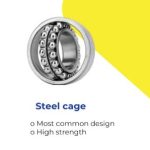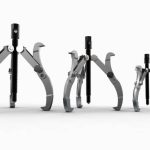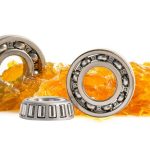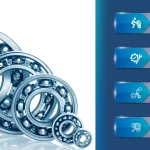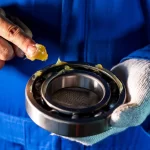Do you know when thrust ball bearings are used? The thrust bearing is utilized if you are working on a mechanical project. By lowering friction, ball thrust bearings are designed to increase your mechanical efficiency. Thrust ball bearings are often used in various industrial applications to increase efficiency. A correct bearing installation is necessary to get the most out of your equipment.
Applying the inadequate bearing can decrease efficiency, increase maintenance requirements, and, worst cases, make it more expensive to remedy equipment failure. The truth is that having a choice of bearing types won’t make your decision-making process any easier. It can take time to choose the best industrial bearings.
What are Thrust ball Bearings?
A thrust bearing is a particular kind of rotary bearing designed to support axial loads and lower friction. The thrust bearings are intended to enable and aid rotation around a fixed shaft or axis, and while a machine is in motion, its rotating components move along them. Transferring thrust loads placed on the shaft and limiting axial shaft drift are two primary purposes of thrust bearings. Thrust bearings are typically positioned against a high thrust collar around a shaft. The thrust collar transfers the shaft’s axial load to the bearing. Thrust collars are usually used in pairs, one on each side of the thrust collar. Although several types of thrust bearings are available to meet the requirements of various applications, they typically consist of two washers or raceways in addition to the rolling elements. They have small metal balls all around the outside to help the rotating sections of a machine.Types of Thrust Bearings
Tapered Roller Thrust Bearing: The amount of thrust this bearing can support is determined by the angle formed between the bearing axis and the line of contact between the raceway and the tapered roller. The bearing is better suited for axial loads if this angle is larger than 45 degrees. Another feature of heavy-duty tapered roller thrust bearings is a second row of opposing tapered rollers. This kind of “screw-down” bearing prevents minor to moderate angular misalignment by changing the curvature of a raceway. Cylindrical Roller Thrust Bearing: Radial patterns of cylindrical rollers are arranged around the bearing axis. To lessen stress, these rollers need to be crowned or end-relieved. They are available in double-row forms and may be deployed in relatively little axial space. They should not be used for radial loads. Spherical Roller Thrust: The raceways closely mimic the cone-and-cup configuration of typically tapered roller bearings, while the rolling elements are fashioned like barrels. This allows the bearing to self-align, which is advantageous in applications where shaft deflection or shock loads may happen. Thrust Ball Bearings: Thrust ball bearings cannot transmit radial loading. This type is prone to misalignment, so producers often add a sphered groove to the housing washer to lessen the likelihood. Although they operate well in high-speed applications, they struggle under enormous loads. Needle Roller Thrust Bearing: Thrust bearings with needle rollers are prized for their low height and many rolling elements. Consequently, their rolling elements sometimes directly contact the rotating parts without a shaft washer or housing washer. Radial loads are zero, but shocks and axial loads are extremely high.How Thrust Bearings Work?
Most thrust bearings employ balls to sustain the machinery they are utilized with. These are referred to as “thrust ball bearings” and have a band of several little metal balls all around them. The image up above shows an illustration of a thrust ball bearing. These thrust ball bearings are employed when a machine’s moving parts apply an axial load. They can help rotate a machine’s moving parts with the arrangement of their balls.Thrust Ball Bearing Applications
Thrust bearings are used in many applications and sectors, including centrifuges and medical devices. Other typical applications comprise:- Automotive
- Transportation
- Generators and Water Turbines
- Heavy-Duty Machineries
- Industrial Machinery
- Mining & Construction
Benefits of Thrust Bearings
Thrust ball bearings are crucial in various applications due to their advantages. Their advantages consist of the following:- Highly reliable
- High load capacity
- Withstand harsh environment
- Easy mounting and dismounting
- High availability
- Function smoothly at high speed




